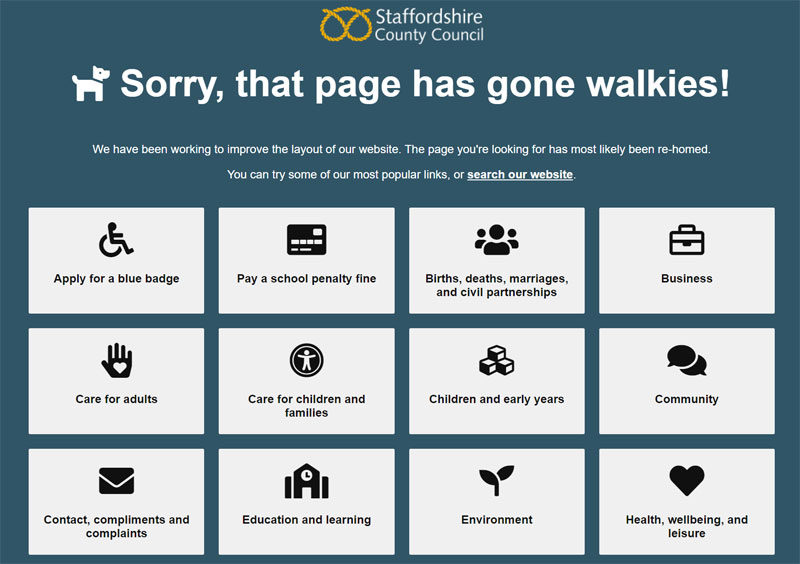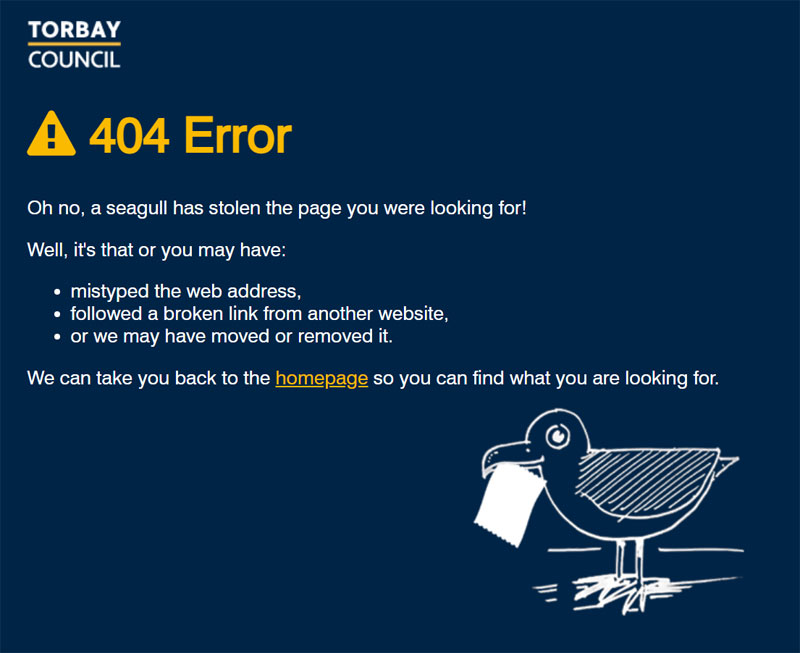What is a 404?
Visitors usually see a 404 page after trying a URL which does not exist. The 404 informs them that the page that they have been searching for is missing. 404 is the HTTP standard response code which indicates that a non-existent page has been reached, perhaps because a broken link has been clicked, a URL has been mistyped, or because the page has been deleted.
A 404 generally presents an error page which doesn’t have any design and doesn’t help visitors to find to a valid page (see example below):

What is a custom 404?
Presenting a generic error page needs to be avoided at all costs as it’s unhelpful to your website visitors and worse still it might alienate them from visiting again. What you need to do is to set up a custom 404 page which helps them to find the information they’re looking for and provides other helpful content that encourages them to explore your site further.
Google has some helpful suggestions when designing a useful custom 404 page:
- Tell visitors clearly that the page they’re looking for can’t be found. Use language that is friendly and inviting.
- Make sure your
404page has the same look and feel (including navigation) as the rest of your site. - Consider adding links to your most popular articles or posts, as well as a link to your site’s home page.
- Think about providing a way for users to report a broken link.
How are councils performing on 404s?
I carried out some research on how councils are performing on 404s. I checked if they had prepared custom 404s, what information they contained and how useful they were to visitors.
Before I did this though I checked to see if there was any advice available to councils which might help them to create effective 404s. The only really useful guidance was located in the GOV.UK design pattern for Page not found pages. This advises that a custom 404 should have:
- ‘Page not found – service name – GOV.UK’ as the page title
- ‘Page not found’ as the H1
- contact information, if it exists and helps meet a user need
It also advises that the content should be clear and concise and not blame the user.
It goes on to stress not to use:
- breadcrumbs
- technical jargon like 404 or bad request
- informal or humorous words like oops
- red text to warn people
An example of the resulting Page not found is presented below:

GOV.UK’s advice seems sensible and applicable to councils, apart perhaps from including the service name – GOV.UK as the page title. For me though it lacks sufficient focus on the visitor and their experience of reaching a custom 404. The tone is also little unwelcoming and apart from providing contact information it doesn’t help visitors to find what they came for in the first place. It would probably therefore be useful to advise visitors how to return to the homepage, access the search or A-Z (if the website has one).
It is perhaps also worth explaining why visitors might have landed on the custom 404, but don’t write a long essay as they won’t thank you for wasting their time. Be polite and by all means apologise, but again keep it brief!
An example of the resulting text might be: ‘Sorry – the page you’re looking for was not found. It’s possible you entered the address incorrectly or are looking for a page that has moved or been deleted.’
A custom 404 page should look like other pages of the website, except for the content. That’s because the aim of the page is to advise visitors that even when the page is missing, they are still on the same website and everything’s going to be okay. Visitors should see recognisable colors, logo, menu and navigation elements, such as a search bar.
It is also worth adding a contact form or email link to allow users to notify you about the problem and report a broken link.
So, in summary, my suggested list of do’s and don’ts for councils when creating a custom 404 is as follows:
A custom 404 should have:
- ‘Page not found’ as the page title
- ‘Page not found’ as the H1
- a polite, but brief explanation for why visitors might have landed on the page
- the same branding and navigation as other pages on the website
- some advice on how visitors can find what they are looking for on the website (for example homepage, search and A-Z)
- contact information (form or link), if it exists and helps meet a user need
A custom 404 should avoid using:
- breadcrumbs
- technical jargon like 404 or bad request
- informal or humorous words like oops
- red text to warn people
Bearing this in mind all of the above I reviewed 404s on 409 council websites throughout the UK and Ireland (see the data at the end of this blog post).
How well do councils perform on custom 404s?
Overall I estimate that only 17 councils (around 4%) meet most of the requirements I have outlined above:
- Amber Valley
- Chesterfield
- Derby
- Ealing
- East Renfrewshire
- East Sussex
- Guildford
- Haringey
- Leicester
- Rochford
- Shropshire
- South Tyneside
- St Helens
- Stroud
- Suffolk
- Uttlesford
- Winchester
The remaining 392 councils (96%) need to make some changes to their custom 404 to make them more useful to visitors.
Councils without custom 404 pages
I found 31 councils (7.6%) that don’t currently have a custom 404. The experience of reaching a council website without a custom 404 is exceedingly poor as the examples below demonstrate.
| Does a 404 custom error page exist? | Yes | No |
| Number of councils | 378 (92.4%) | 31 (7.6%) |
Council websites using Umbraco
5 councils using Umbraco as their content management system (Brigend, Bromsgrove, Redditch, Rushcliffe and Sefton) have failed to implement a custom 404 and so visitors are presented with a message such as:

Council websites using Drupal
Two councils using Drupal as their content management system (Cannock Chase and Stafford) are presenting the following error:

Councils presenting server error messages
14 councils (3.4%) present server error messages similar to the example presented below (Ceredigion, Conwy, Dacorum, Galway, Hastings, Kildare, Leitrim, Longford, Louth, Roscommon, Sligo and Tameside). Please note that the errors don’t specifically relate to the content management system that they are using.

Page titles used by councils on custom 404 pages
207 councils (51%) have added the page title of ‘Page not found’ on their custom 404.
84 councils (21%) present the page title as 404 or Error 404, which is meaningless to most visitors. 21 councils (5%) prefixed the page title with ‘Oops’ or ‘Whoops’.
9 councils (2%) fail to present any page title on a custom 404 page.
Councils failing to apply page branding to their custom 404 pages
15 councils with custom 404s (3.6%) currently fail to apply any page branding to their custom 404 pages. Failing to add page branding doesn’t inspire confidence to visitors that they have landed on the website that they expected. These councils need to consider adding page branding to their custom 404s. The example below is particularly popular:

Councils that apply creative design to their custom 404 pages
4 councils go beyond adding a standard error message by using creative design and content. Although elements of each of their custom 404s need improving I think they need to be congratulated for applying creativity and a sense of humour to their pages to make them more appealing and personable.
Dundee City Council

Staffordshire County Council

Torbay Council

Liverpool City Council

Some closing thoughts
The overall performance of councils with regards to custom 404s is pretty patchy and in need of attention. I am surprised that something which is a website fundamental doesn’t appear to have been given much attention.
A large number of websites that I reviewed blamed the likelihood of page errors on recent website redevelopments. That may be a factor, but the number of councils stating this was significant and I am aware that the number of councils who have redeveloped their websites over the last couple of years is nowhere near as great. I suspect that councils have custom 404s on their to do list when they are redeveloping their websites, then largely forget about them once the redevelopment has been completed.
The good news is that custom 404s are pretty straight forward to update and it shouldn’t take councils long to put things right. I hope that the information and guidance that I have provided in this blog post will prove helpful. If any council wants any help I’d be more than happy to advise. If this is of interest please get in contact.

